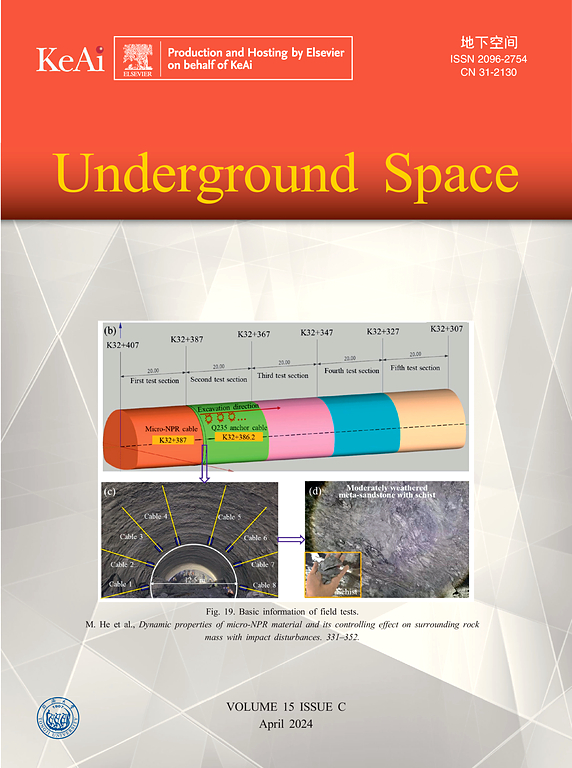高地应力水平层状岩体隧道结构环形成机理
IF 8.3
1区 工程技术
Q1 ENGINEERING, CIVIL
引用次数: 0
摘要
在地应力较大的层状岩石中开挖隧道会造成较大的变形灾害,合理的对策依赖于对围岩自承载能力的充分了解。本文引入结构环的概念来表示水平层状围岩的承载能力,分析了其形成机理和确定方法。首先,分析了水平层状围岩开挖的力学响应特征;基于应力传递机理,提出了一定厚度的封闭结构环的新概念。以应力单元为基本解析模型,采用最大压应力增加比对结构环进行表征。然后提出结构环边界的确定方法及其实现算法,在此基础上对层状岩体的梁拱特性进行了研究。进行了一系列模型试验,验证了所提出的结构环概念及其确定方法。通过参数化研究,说明了地质条件和隧道几何形状对结构环位置和形状的影响。并对结构环概念在支撑设计中的应用进行了探讨。构造环通常呈椭圆形,主轴方向与主导地应力方向一致。岩层对构造环有显著影响,梁拱性质受夹层和层理间距的影响。支撑体系有利于结构环的形成,在设计时应兼顾支撑能力和结构环的稳定性。本文章由计算机程序翻译,如有差异,请以英文原文为准。
Formation mechanism of the structural ring for tunnels in horizontal layered rock with high geostress
Tunnelling in layered rock with high geostress can cause large deformation disasters, and the reasonable countermeasures rely on a full understanding of the self-bearing capacity of the surrounding rock. In this article, the structural ring concept was introduced to represent the load-bearing capacity of the horizontal layered surrounding rock, whose formation mechanism and determination method were analyzed. Firstly, the mechanical response characteristics of the horizontal layered surrounding rock due to excavation were analyzed. Based on the stress transfer mechanism, the new concept of the structural ring which is a closed structure with a certain thickness was presented. Taking the stress element as the basic analytical model, the maximum increase ratio of the compressive stress was adopted to characterize the structural ring. Then the determination method and its implementation algorithm of the structural ring boundaries were proposed, based on which the beam-arch property of the layered rock was investigated. A series of model tests were carried out to validate the proposed structural ring concept and its determination method. Parametric studies were conducted to illustrate the effect of geological conditions and tunnel geometry on the position and shape of structural rings. Furthermore, the application of the structural ring concept in support design was discussed. It was found that the structural ring was usually oval-shaped with the major axis direction consistent with the dominant in-situ stress. Rock layers had a significant effect on the structural ring, and the beam-arch property was affected by the interlayers and bedding spacing. The support system was beneficial for the formation of the structural ring, which should be designed to balance the support capacity and the stability of the structural ring.
求助全文
通过发布文献求助,成功后即可免费获取论文全文。
去求助
来源期刊

Underground Space
ENGINEERING, CIVIL-
CiteScore
10.20
自引率
14.10%
发文量
71
审稿时长
63 days
期刊介绍:
Underground Space is an open access international journal without article processing charges (APC) committed to serving as a scientific forum for researchers and practitioners in the field of underground engineering. The journal welcomes manuscripts that deal with original theories, methods, technologies, and important applications throughout the life-cycle of underground projects, including planning, design, operation and maintenance, disaster prevention, and demolition. The journal is particularly interested in manuscripts related to the latest development of smart underground engineering from the perspectives of resilience, resources saving, environmental friendliness, humanity, and artificial intelligence. The manuscripts are expected to have significant innovation and potential impact in the field of underground engineering, and should have clear association with or application in underground projects.
 求助内容:
求助内容: 应助结果提醒方式:
应助结果提醒方式:


